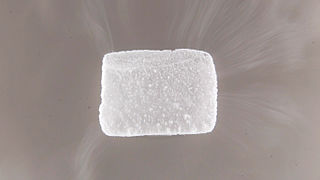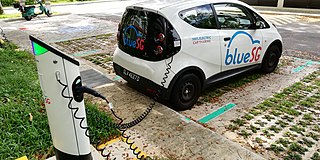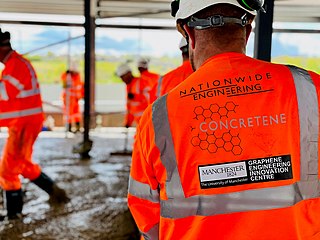
Dry ice colloquially means the solid form of carbon dioxide ( (s)). It is commonly used for temporary refrigeration as CO2 does not have a liquid state at normal atmospheric pressure and sublimes directly from the solid state to the gas state. It is used primarily as a cooling agent, but is also used in fog machines at theatres for dramatic effects. Its advantages include lower temperature than that of water ice and not leaving any residue (other than incidental frost from moisture in the atmosphere). It is useful for preserving frozen foods (such as ice cream) where mechanical cooling is unavailable.
XPRIZE foundation is a non-profit organization that designs and hosts public competitions intended to encourage technological development. The XPRIZE mission is to bring about "radical breakthroughs for the benefit of humanity" through incentivized competition. It aims to motivate individuals, companies, and organizations to develop ideas and technologies.

Coal pollution mitigation, sometimes labeled as clean coal, is a series of systems and technologies that seek to mitigate health and environmental impact of burning coal for energy. Burning coal releases harmful substances, including mercury, lead, sulfur dioxide (SO2), nitrogen oxides (NOx), and carbon dioxide (CO2), contributing to air pollution, acid rain, and greenhouse gas emissions. Methods include flue-gas desulfurization, selective catalytic reduction, electrostatic precipitators, and fly ash reduction focusing on reducing the emissions of these harmful substances. These measures aim to reduce coal's impact on human health and the environment.

Clean technology, in short cleantech or climatetech, is any process, product, or service that reduces negative environmental impacts through significant energy efficiency improvements, the sustainable use of resources, or environmental protection activities. Clean technology includes a broad range of technology related to recycling, renewable energy, information technology, green transportation, electric motors, green chemistry, lighting, grey water, and more. Environmental finance is a method by which new clean technology projects can obtain financing through the generation of carbon credits. A project that is developed with concern for climate change mitigation is also known as a carbon project.
GreenFuel Technologies Corporation (GFT) was a startup that developed a process of growing algae using emissions from fossil fuels to produce biofuel from algae.

Greentech Media, also known as GTM, was a media company based in Massachusetts, United States, that generated online daily reports, market research studies, and news on green technology and green jobs.

Capital Power is a North American independent power generation company based in Edmonton, Alberta, Canada. It develops, acquires, owns and operates power generation facilities using a variety of energy sources.
Enhanced weathering, also termed ocean alkalinity enhancement when proposed for carbon credit systems, is a process that aims to accelerate the natural weathering by spreading finely ground silicate rock, such as basalt, onto surfaces which speeds up chemical reactions between rocks, water, and air. It also removes carbon dioxide from the atmosphere, permanently storing it in solid carbonate minerals or ocean alkalinity. The latter also slows ocean acidification.

Boundary Dam Power Station is the largest coal fired station owned by SaskPower, located near Estevan, Saskatchewan, Canada.

Mike Schroepfer is an entrepreneur, technical architect, climate investor, and philanthropist who was the chief technology officer (CTO) at Meta Platforms between March 2013 and March 2022. In 2022 he took a step back and transitioned to become Senior Fellow at Meta to focus on investing and philanthropic work related to addressing the climate crisis. Schroepfer's current focus is investing in tech and science to fight climate change through his VC firm Gigascale Capital, philanthropic entity Additional Ventures, and as board chair of the Carbon to Sea Initiative.

Deforestation is a primary contributor to climate change, and climate change affects forests. Land use changes, especially in the form of deforestation, are the second largest anthropogenic source of atmospheric carbon dioxide emissions, after fossil fuel combustion. Greenhouse gases are emitted during combustion of forest biomass and decomposition of remaining plant material and soil carbon. Global models and national greenhouse gas inventories give similar results for deforestation emissions. As of 2019, deforestation is responsible for about 11% of global greenhouse gas emissions. Carbon emissions from tropical deforestation are accelerating. Growing forests are a carbon sink with additional potential to mitigate the effects of climate change. Some of the effects of climate change, such as more wildfires, insect outbreaks, invasive species, and storms are factors that increase deforestation.
Liquid Light is a New Jersey-based company that develops and licenses electrochemical process technology to make chemicals from carbon dioxide (CO2). The company has more than 100 patents and patent applications for the technology that can produce multiple chemicals such as ethylene glycol, propylene, isopropanol, methyl-methacrylate and acetic acid. Funding has been provided by VantagePoint Capital Partners, BP Ventures, Chrysalix Energy Venture Capital, Osage University Partners and Sustainable Conversion Ventures. Liquid Light's technology can be used to produce more than 60 chemicals, but its first targeted process is for the production of monoethylene glycol (MEG) which has a $27 billion annual market. MEG is used to make a wide range of consumer products including plastic bottles, antifreeze and polyester fiber.
Breakthrough Energy is the umbrella name of several organizations, founded by Bill Gates in 2015, that aim to accelerate innovation in sustainable energy and in other technologies to reduce greenhouse gas emissions. It invests in a variety of startup companies that are attempting to commercialize new concepts such as nuclear fusion, large-capacity batteries to store renewable energy, and microbe-generated biofuels.

Carbon Engineering Ltd. is a Canadian-based clean energy company focusing on the commercialization of direct air capture (DAC) technology that captures carbon dioxide directly from the atmosphere.
The Allam Cycle or Allam-Fetvedt Cycle is a process for converting carbonaceous fuels into thermal energy, while capturing the generated carbon dioxide and water. This zero emissions cycle was validated at a 50 MWth natural gas fed test facility in La Porte, Texas in May 2018. This industrial plant is owned and operated by NET Power LLC, a privately held technology licensing company. NET Power is owned by Constellation Energy Corporation, Occidental Petroleum Corporation (Oxy) Low Carbon Ventures, Baker Hughes Company and 8 Rivers Capital, the company holding the patents for the technology. The key inventors behind the process are English engineer Rodney John Allam, American engineer Jeremy Eron Fetvedt, American scientist Dr. Miles R Palmer, and American businessperson and innovator G. William Brown, Jr. The Allam-Fetvedt Cycle was recognized by MIT Technology Review on the 2018 list of 10 Breakthrough Technologies.

Direct air capture (DAC) is the use of chemical or physical processes to extract carbon dioxide directly from the ambient air. If the extracted CO2 is then sequestered in safe long-term storage, the overall process will achieve carbon dioxide removal and be a "negative emissions technology" (NET).

Etosha R. Cave is an American mechanical engineer based in Berkeley, California. She is the co-founder and Chief Scientific Officer of Twelve, a startup that recycles carbon dioxide.

Concretene is a graphene-enhanced admixture for concrete that delivers savings on cost and CO2 emissions. The formulation has been developed by Nationwide Engineering Research & Development (NERD) in collaboration with The University of Manchester's Graphene Engineering Innovation Centre (GEIC).
The Climate Pledge Fund is a division of Amazon, set up to develop and manage investments in the climate technology space, as part of its Climate Pledge initiative. It is a corporate venture capital fund.
Carbon tech is a group of existing and emerging technologies that are rapidly transforming oil and gas to low emissions energy. Combined, these technologies take a circular carbon economy approach for managing and reducing carbon footprints, while optimizing biological and industry processes. It builds on the principles of the circular economy for managing carbon emissions: to reduce the amount of carbon emissions entering the atmosphere, to reuse carbon emissions as a feedstock in different industries, to recycle carbon through the natural carbon cycle with bioenergy, and to remove carbon and store it. Carbon tech provides a third option for climate and environmental policy as an alternate to the binary business as usual and radical change.











